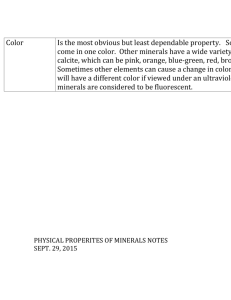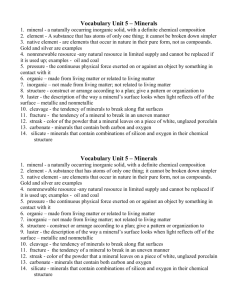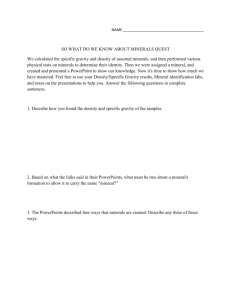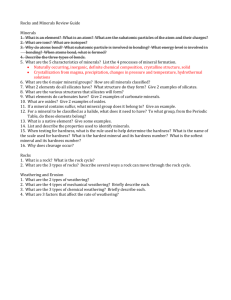Chapter 5: Minerals
advertisement
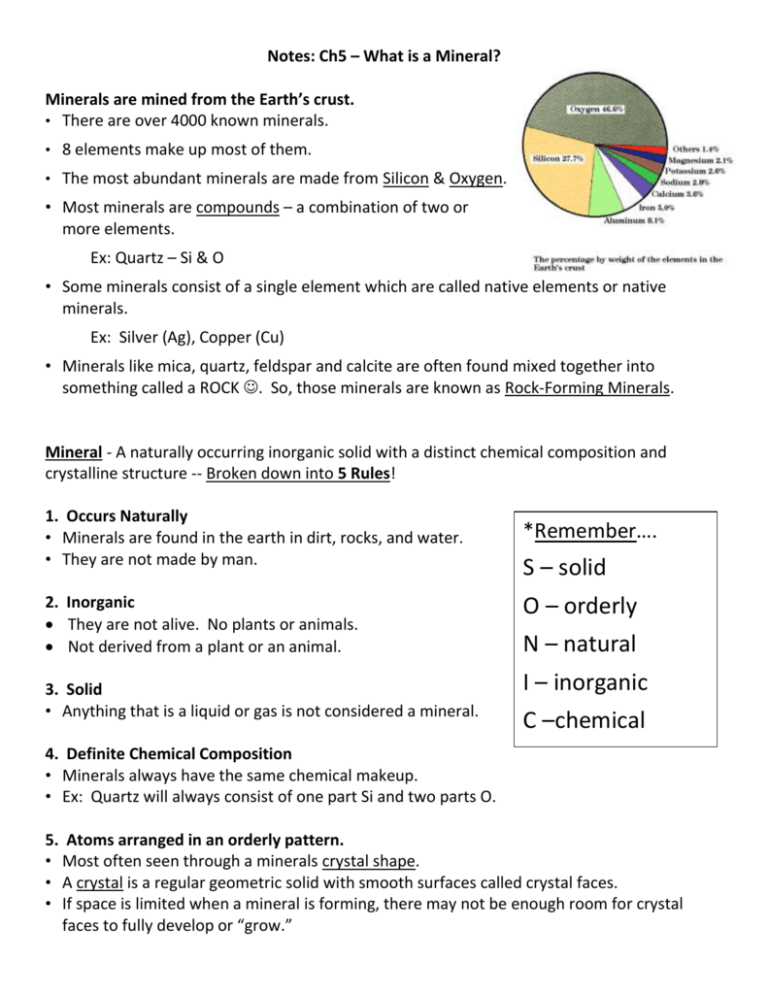
Notes: Ch5 – What is a Mineral? Minerals are mined from the Earth’s crust. • There are over 4000 known minerals. • 8 elements make up most of them. • The most abundant minerals are made from Silicon & Oxygen. • Most minerals are compounds – a combination of two or more elements. Ex: Quartz – Si & O • Some minerals consist of a single element which are called native elements or native minerals. Ex: Silver (Ag), Copper (Cu) • Minerals like mica, quartz, feldspar and calcite are often found mixed together into something called a ROCK . So, those minerals are known as Rock-Forming Minerals. Mineral - A naturally occurring inorganic solid with a distinct chemical composition and crystalline structure -- Broken down into 5 Rules! 1. Occurs Naturally • Minerals are found in the earth in dirt, rocks, and water. • They are not made by man. 2. Inorganic They are not alive. No plants or animals. Not derived from a plant or an animal. 3. Solid • Anything that is a liquid or gas is not considered a mineral. *Remember…. S – solid O – orderly N – natural I – inorganic C –chemical 4. Definite Chemical Composition • Minerals always have the same chemical makeup. • Ex: Quartz will always consist of one part Si and two parts O. 5. Atoms arranged in an orderly pattern. • Most often seen through a minerals crystal shape. • A crystal is a regular geometric solid with smooth surfaces called crystal faces. • If space is limited when a mineral is forming, there may not be enough room for crystal faces to fully develop or “grow.” Crystals A mineral’s crystal shape and hardness are determined by the arrangement of atoms. The 6 Basic Crystal Shapes Cubic 3 equal-length axes of symmetry All 90° angles Halite / Pyrite Orthorhombic 3 unequal axes of symmetry All 90° angles Topaz Tetragonal 3 axes of symmetry: 2 same length, one different All 90 ° angles Zircon Monoclinic 3 unequal axes of symmetry Two at 90° angles, one not Gypsum / Calcite Hexagonal 4 axes of symmetry 3 same length at 120° angle 1 different length at 90° angle Quartz Triclinic 3 unequal axes of symmetry No 90 ° angles Feldspar GEMSTONES are mineral crystals that are cut and polished and used to make jewelry. 3 Ways that Minerals Form 1. From the cooling of molten rock (magma/lava). 2. From evaporation or precipitation out of liquids. Ex: Water evaporates and leaves minerals behind. 3. Existing minerals are transformed by extreme heat & pressure. NOTES: CH 5 – HOW CAN WE IDENTIFY MINERALS? MINERAL PROPERTIES To identify a mineral, we look at their different properties such as…Color, Luster, Streak, Cleavage vs. Fracture, Hardness, & Specific Gravity The characteristics of a mineral can help you identify a mineral. For example: 1. Color - the least important property of a mineral, since chemical impurities can change the color of the same mineral 2. Luster - The property that describes the way a mineral shines in light. Described as Metallic (looks like a metal) or Nonmetallic 3. Streak - The property of a mineral that describes its color in powdered form When a mineral is rubbed across an unglazed tile of white porcelain (a streak plate), it leaves a line of powder. The color of the streak is always the same. For example, quartz leaves a white streak, whether it's violet (amethyst), pink (rose quartz), or brown (smoky quartz). 4. Cleavage - The tendency of a mineral to split along flat surfaces where bonds are weakest. Some minerals break only in one direction; others break in two or more directions. Cubic: form cubes Rhombohedral: form six-sided prisms Basal: occur along a single plane parallel to the base (flat layers) 5. Fracture - The property of a mineral that describes an irregular pattern of breakage in a direction other than along cleavage planes. The mineral splits in no particular direction when broken. Conchoidal Fracture: smooth, curved fracture like the inside of a clam shell Fibrous/Splintery Fracture: looks like splinters 6. Hardness - The resistance of a mineral to scratching Moh’s Scale of Hardness: 7. Specific Gravity - The ratio of the weight of a substance to the weight of an equal volume of water. 8. Other Properties - Any other special property of a mineral that distinguishes it from others. • Double Refraction: when a mineral splits the light rays that pass through it, making a single object appear as two objects when you look through the mineral (example calcite) • Magnetic: affects a compass (example magnetite) • Fluorescent: when a mineral glows under an ultraviolet light (example fluorite) • Salty taste: when a mineral tastes like salt (example halite.) DO NOT TEST YOUR MINERALS FOR THIS!!! • Radioactive: when a mineral gives off subatomic particles that are detected by a Geiger counter (example uraninite.) • Chemical Tests: when hydrochloric acid is dropped on the mineral Calcite, it will fizz or “Effervesce.”The released bubbles are carbon dioxide gas. • Some minerals can be identified by SMELL for example Sulfur can smell like rotten eggs or a burnt match.




